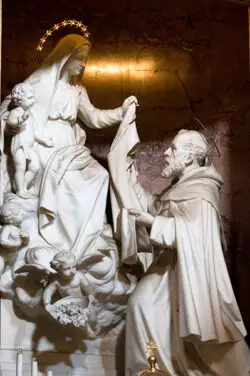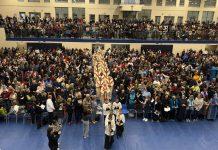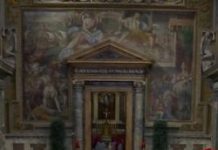May 16, memorial of Saint Simon Stock, a Carmelite who received the scapular of Carmel from the hands of Mary, heralding a period of glory for Marian devotion and for the Holy Church.
Newsdesk (16/05/2025 09:36, Gaudium Press) The son of a noble family of English barons, he was born in 1164, at Harford Castle, in the county of Kent, where his father was governor. Complications during pregnancy, resulting from the robust build of the unborn child, made it fearful that the child would die at the time of his birth. Nevertheless, the pious baroness consecrated the boy to Our Lady and he came into the world without any major difficulties. And, “from the cradle, Simon had the most tender devotion to the Mother of God.”
As a sign of gratitude, the mother would renew her offering before breastfeeding by praying a Hail Mary on her knees. When she forgot, through distraction, the baby would refuse to feed.
It is said that the boy abstained from breast milk on Saturdays and on the eve of Marian feasts, and that to soothe him in any discomfort it was enough to show him an image of the Virgin Mary.
Gifted with rare intelligence, before he was one year old he knew the Hail Mary and learned to read as soon as he could speak. Following his parents’ example, he began to recite the Little Office to the Blessed Virgin very early on, a custom he never abandoned. At the age of six he understood Latin and, burning with love, he prayed the Psalms several times a day, kneeling, out of respect for the Word of God.
Growth in science and virtue
Feeling unable to guide the studies of such a precocious son, after guiding him in his first letters, his father took him to Oxford, where he “was wise at the age when children begin to study”.
As his knowledge grew, his devotion to Our Lady became more refined. At the age of twelve, while reading a treatise on the Immaculate Conception – seven centuries before the proclamation of the dogma! – he felt such an outburst of love that, moved by “the desire to have some resemblance to the purest of virgins, whom he had always taken as his Mother, he consecrated his virginity to God.”
The delicacy of his conscience and the fear of staining his purity helped him to avoid even what appeared to be sin. And his asceticism made him escape from his father’s vigilance and, as a penance, take as his daily ration raw herbs, vegetable salad and wild fruits, with bread and water.
All this aroused great envy in his older brother who, despite his father’s advice, led a dissolute and worldly life. The young Simon’s holiness was therefore a constant reproach to him. Initially, he set traps for his innocence, followed by beatings for his piety, and then moving on to open persecution, with slander and ill-treatment.
Long period of solitude
Fearing that he would fall into the seductions of the world and moved by an interior movement of grace, at the tender age of twelve Simon decided to embrace solitude, taking refuge in a vast forest near Oxford. There he found a tree of extraordinary dimensions with a large cavity in its trunk and improvised a cell in it. A crucifix and an image of Our Lady, the only objects he had brought with him, served as decoration for his sober dwelling. For food he gathered herbs, bitter roots and wild fruits.
Amidst consolations, a new path of temptations and trials began for Simon. The devil provoked in him scruples, fears and cruel remorse for sins he had never committed. To overcome them, he intensified his austerities and prayers and, with the help of the Blessed Virgin, he always emerged victorious.
He passed the time quickly! Much favored by special graces, he received a visit from Our Lady, who expressed to him God’s satisfaction with the twenty years of solitary life he had already spent. She then revealed to him that he had been chosen to join the Carmelite Order when it came from the Holy Land to England, but that he would face the contradictions that it would face under his leadership.
Entry into the Order of Carmel
In order to better prepare himself for these future events, Simon returned to Oxford to complete his theology studies and receive the priestly ministry. However, God’s plans do not follow human rhythms: the first Carmelites would not set foot on English soil for another fifteen years…
In the meantime, our Saint had returned to a solitary life. In 1212, the first religious from Mount Carmel finally arrived in England. Upon receiving such good news, announced by the Blessed Virgin herself, Simon hurried to join them, who had been given the task of beginning the foundation of monasteries on the island.
Hoping for better days, the monks retired to a forest in Aylesford, owned by a Carmelite friar of English origin, and began to live as anchorites. There the novice received the Carmelite habit from the hands of Blessed Alain, then prior of the small community.
Knowing the rare talents of our Saint, this superior ordered him to return to Oxford and obtain a doctorate in Theology, despite his repugnance for the worldly environments he would be forced to frequent. The religious obeyed, but once he had obtained the title, he took advantage of the favorable circumstances offered by the founding of a Carmelite hermitage near Norwich to return to solitary life, together with other religious who had come from Palestine.
First obstacles to overcome
Step by step, Our Lady’s prophecies were fulfilled. Saint Brocard, the second Western Superior of the Order, knowing the wonders of grace worked among the solitary men of Norwich, especially in favor of Simon, wanted to have him as his assistant, and in the General Chapter of 1215 he appointed him Vicar General for all of Europe, where the number of houses had multiplied in a very short time.
Because of the enormous good done to the Church, the father of envy incites tremendous persecution against the order: encouraged by false zeal, some personalities try to suppress it, under the pretext of contradicting the dictates of the Fourth Lateran Council.
Vigilant, Simon united the whole of Carmel in prayer and appealed to Pope Honorius III. The Pontiff sent two commissioners to find out about the situation on the spot , but they allowed themselves to be seduced by opponents. However, Mary Most Holy came to the aid of her children: the Pope declared that the Queen of Heaven had ordered him to “approve the rule of Carmel, confirm the order and protect it against the onslaught of its adversaries.”
Retreat on Mount Carmel
The time had finally come for the Carmelite Order to leave the Holy Land for more favorable places, as Our Lady had predicted. By order of Blessed Alain, already elected Superior General, Simon Stock traveled to Mount Carmel to participate in the General Chapter, convened to remedy the evils suffered in the East due to Saracen intolerance. The English Carmelite was filled with indescribable joy when he saw the prophetic mountain where everything had begun with Elijah.
The Chapter decided, in fact, that all the Carmelites would emigrate to Europe, despite the objections of some of those present who said they could not in conscience abandon the few Christians in the East. Saint Simon considered, however, that it was useless to expose themselves to such grave danger, recalling an evangelical principle: “If they persecute you in one city, flee to another” (Mt 10:23).
The Carmelite tradition tells us that he spent six years leading a life of prayer on the Mount of Elijah, waiting for a suitable opportunity to return to his country. This opportunity came when some English nobles who had fought in the Holy Land offered to let the religious embark on their ships to return to their homeland, where they would be distributed among the various monasteries that already existed. Saint Simon and the Superior General headed for Aylesford.
Sign of predilection and alliance with Our Lady
 It was the year 1245 when Blessed Alain convened the first General Chapter in Europe, during which he presented his resignation and Saint Simon Stock was unanimously elected to replace him, at the age of eighty. Under his rule the order expanded notably, especially in France, where the number of foundations multiplied, thanks to the patronage of Saint Louis IX.
It was the year 1245 when Blessed Alain convened the first General Chapter in Europe, during which he presented his resignation and Saint Simon Stock was unanimously elected to replace him, at the age of eighty. Under his rule the order expanded notably, especially in France, where the number of foundations multiplied, thanks to the patronage of Saint Louis IX.
Even with the protection of the Holy See, Carmel was the target of new and virulent persecutions aimed at suppressing it. At the height of his affliction, the Saint devoted himself to prayers, fasting and penance, which ended up lasting several years. It was during this time that he composed the famous antiphon Flos Carmeli , which he began to recite every day.
However, “in the works that Our Lady loves, things can reach the point of falling apart, almost completely shattering. Everything seems lost, but this is the moment that She reserves to intervene.”
On July 16, 1251, the prayer of the venerable Carmelite, “like that of the prophet Elijah, opened Heaven and made the Queen of Angels descend.” On that date, “the Most Holy Virgin appeared to him, dressed in the habit of the order, crowned with sparkling stars, and holding her Divine Son in her arms.” In her hands she carried the scapular, which she gave to him as the treasurer of her sign of predilection and of an everlasting covenant.
On the same day, Saint Simon delivered to Father Pierre Swayngton, his secretary and confessor, a letter addressed to all his brothers in the habit, in which he recorded the promise of the Mother of God of which he had been the depositary:
“ Receive, my beloved son, this scapular of your order, as a distinctive sign and the mark of the privilege which I have obtained for you and all the sons of Carmel; it is a sign of salvation, a safeguard in dangers and a guarantee of peace and special protection until the end of time. Ecce signum salutis, salus in periculis. Whoever dies clothed in this habit will be preserved from eternal fire.”
Long life united with Mary
From then on, the Carmelite Order expanded prodigiously and at the end of the 13th century, a few years after the Saint’s death, it already had, according to sources of the time, more than seven thousand monasteries and hermitages, with around one hundred and eighty thousand religious.
Saint Simon Stock devoted his remaining years to visiting the Carmels. He visited various cities in Belgium, Scotland, Ireland and other countries, and in 1265 arrived in Bordeaux, France, where on May 16 he surrendered his soul to God. His last words were the first he had learned to say: Hail Mary.
Text extracted, with adaptations, from the Arautos do Evangelho Magazine no. 185, May 2017. By Sister Juliane Vasconcelos Almeida Campos, EP.


































